Conclusions from the tasting:
This Australian reds tasting based on 2004 and 1971 wines was an absolute adventure for participants. Not only did we have some of Australia's most ‘famous’ wines, but also some of its ‘finest’. Given Australian pride in its red wines, coupled at times with domestic speakers having less familiarity with relevant international benchmark wines, these two descriptors do not always coincide, at least in the estimation of tasters beyond Australian shores.
Of the 21 tasters present, only two had previously made the essential (to wine learning) comparison of Penfolds Grange Shiraz 100% new American oak, vs Penfolds Shiraz RWT c70% new all-French oak, vs Penfolds Cabernet Sauvignon Bin 707, 100% new American oak, the wines all from the same vintage. These three labels in their best years in one sense define Australian red wine attitudes and enthusiasms. Understanding them is essential to understanding Australian red wine. And nobody at all had tasted the even rarer / more special Penfolds Cabernet Sauvignon Bin 42, and Penfolds Cabernet / Shiraz Bin 60A. So, an adventure indeed.
And at the other end of the tasting, none present had tasted three Australian reds of repute, all of the same year, when each wine is 50 years old.
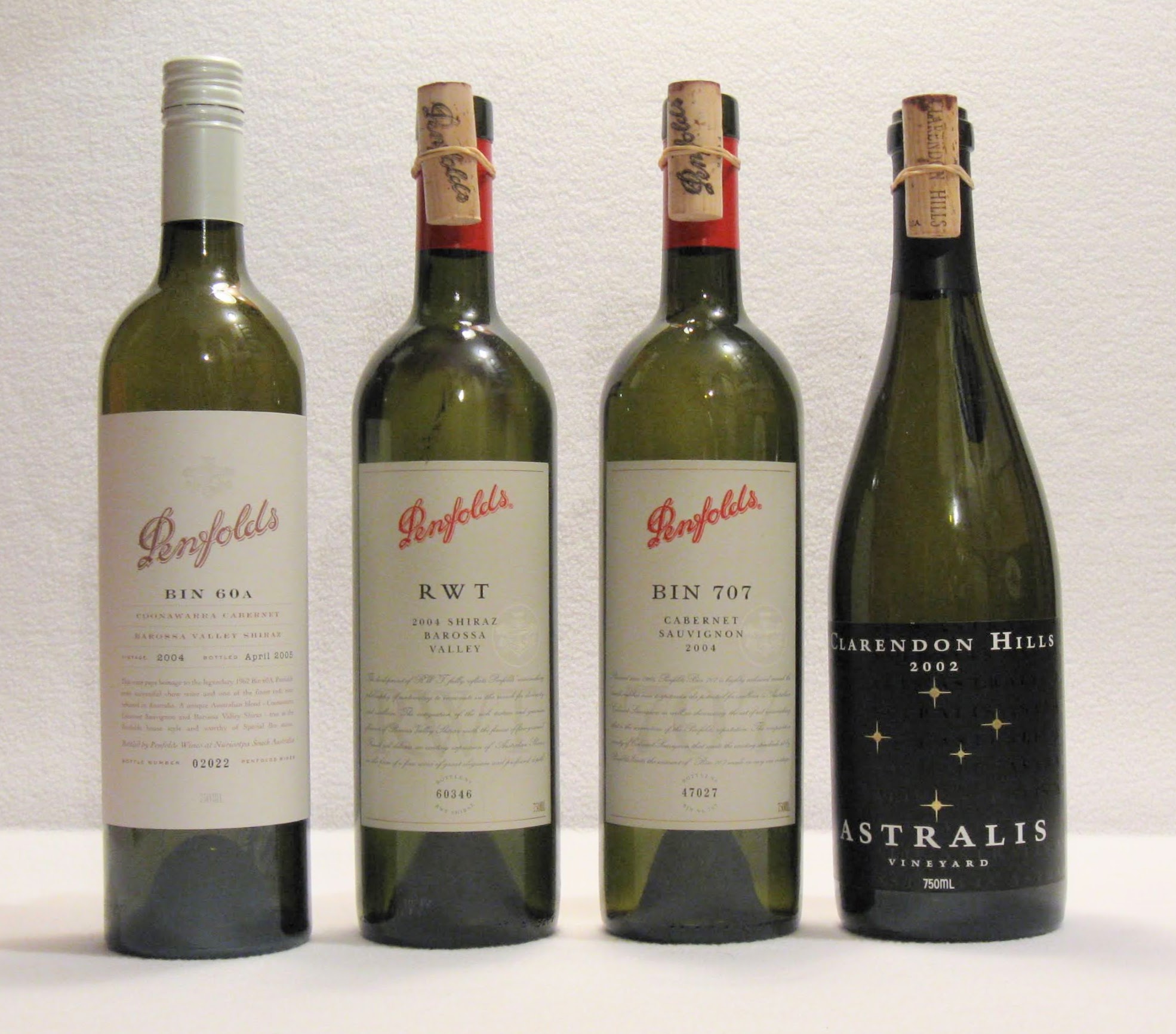
The top four wines of this tasting all rated 19 or more points. In this review, the gentler and subtler wines, those better suited to enjoying with food, gained points. From the left, the near-legendary 2004 Penfolds Cabernet Shiraz Bin 60A, clearly cabernet sauvignon on bouquet at this stage, but then the palate filled out and ‘sweetened’ by very pure shiraz, a wine of great refinement, 19.5; 2004 Penfolds Shiraz RWT, shiraz ripened to the blueberry level on bouquet, but still nearly syrah in its quality, 19 +; next the long-standing pure cabernet sauvignon 2004 Penfolds Bin 707, intensely cassisy, highly fragrant, remarkable concentration, gentler than some examples from earlier years, 19 +; and finally the highly-regarded but sometimes contentious 2002 Clarendon Hills Syrah Astralis, in a particularly elegant showing, 19.
Thus, to say people were interested in the 12 wines is a clinical understatement. A better measure is that all but one of the wines was somebody's top or second favourite wine of the evening. This is a remarkable endorsement both of the wines, and also tasters’ ability to accommodate both very young, and very old wines. Further, despite four of the wines having current (unrealistic, in auction terms) wine-searcher valuations approaching $NZ1,000, there was no head-and-shoulders favourite wine. There was, therefore, much for tasters to enjoy.
An introduction to the style of Penfolds red wines, and the now legendary Max Schubert, is given in my 2017 article: Do Penfolds reds including Grange cellar for 50 years, here. Much more information about Max Schubert and his pivotal role in the evolution of Penfolds red wine styles is available on the Net.
As an outside calibration wine for the expensive 2004 Penfolds wines, at the writing-up stage I opened Le Petit Vin d’Avril, of the same age. This wine is ‘famous’ in that Vincent Avril uses it to condition his new barrels, so there is no new oak aggression in his grand vin, Clos des Papes. The whole wine-making style of Clos des Papes is therefore the polar opposite of Penfolds. This wine is also remarkable in the Southern Rhone Valley, in that it contains both cabernet sauvignon and merlot: it is thus merely a Vin de France. This sometimes wonderful but all-too-often overlooked wine is anything but 'Petit': at best it can be both substantial, and long-lived. The results were more than illuminating, if assessing wine quality to international standards be the goal.
Invitation / Introduction:
The heart of the tasting is a comparative evaluation of the top 2004 red Bins from Penfolds Wines. Given the growing reputation of Penfolds as a winery, this is a tasting to go out of your way for, simply because 2004 was a cooler year in South Australia, and therefore (within the Penfolds context), the wines are more varietal, more aromatic, and somewhat subtler than usual.
The tasting includes some of Australia's greatest reds. Some are more expensive than Grange, which means, now that the release price for current Penfolds Grange is $850 (or more), that the tasting cannot be cheap. But the tasting is also rare, these wines rarely being seen together. The Giaconda and Clarendon Hills shiraz wines are nearly as famous as Penfolds, and rarer. They will provide a kind of calibration role.
To counterpoint the young wines, and some will still be very young, we have a 1971 Penfolds 389 which back then drew on the fruit now going into these latter-day top-end Bins, a 1972 Penfolds St Henri not often offered with age, and both the 1971 Tahbilk Cabernet and the 1971 Tahbilk Shiraz. For many years, 1971 was regarded as the absolute benchmark vintage for Tahbilk reds. It will be fun to see these wines at 50 years age exactly.
References:
Evans, Len, 1978: Complete Book of Australian Wine, Third Edition. Paul Hamlyn, 512 p.
Halliday, James, 2002: Classic Wines of Australia and New Zealand, Third Edition. 386 p. Harper-Collins.
Lake, Max, 1966: Classic Wines of Australia. Jacaranda Press, 134 p.
Read, A, & A Caillard, 2000: The Rewards of Patience, Fourth Edition. 144 p. Penfolds.
www.jancisrobinson.com = Jancis Robinson MW and Julia Harding MW, subscription needed for reviews
www.penfolds.com/en-au/wines/tasting-notes.html short-cut to the core of the hard-to-use Penfolds website, most of the wines in ‘The Penfolds Collection’, Bin 60A and Block 42 in ‘Special Bins’.
www.robertparker.com = Robert Parker and Joe Czerwinski, vintage chart, subscription needed for reviews
www.winespectator.com = vintage chart, subscription needed for reviews
THE WINES REVIEWED:
At the decanting stage, the wines all seemed sound, so no Reserve wines (listed at foot) were needed. The first price given is the current wine-searcher value, but note that for Penfolds in particular, wine-searcher is unduly influenced by the world-wide demand for Penfolds wines currently. Penfolds has been particularly desirous of becoming well-known in the East. Thus the prices for older bottles offered by wine retailers overseas is often far, far higher than the same wine will fetch at auction, in Australia or New Zealand. An approximate indication of the original purchase price is in the text following, if clues are available. Most wines have been cellared in Wellington since original purchase.
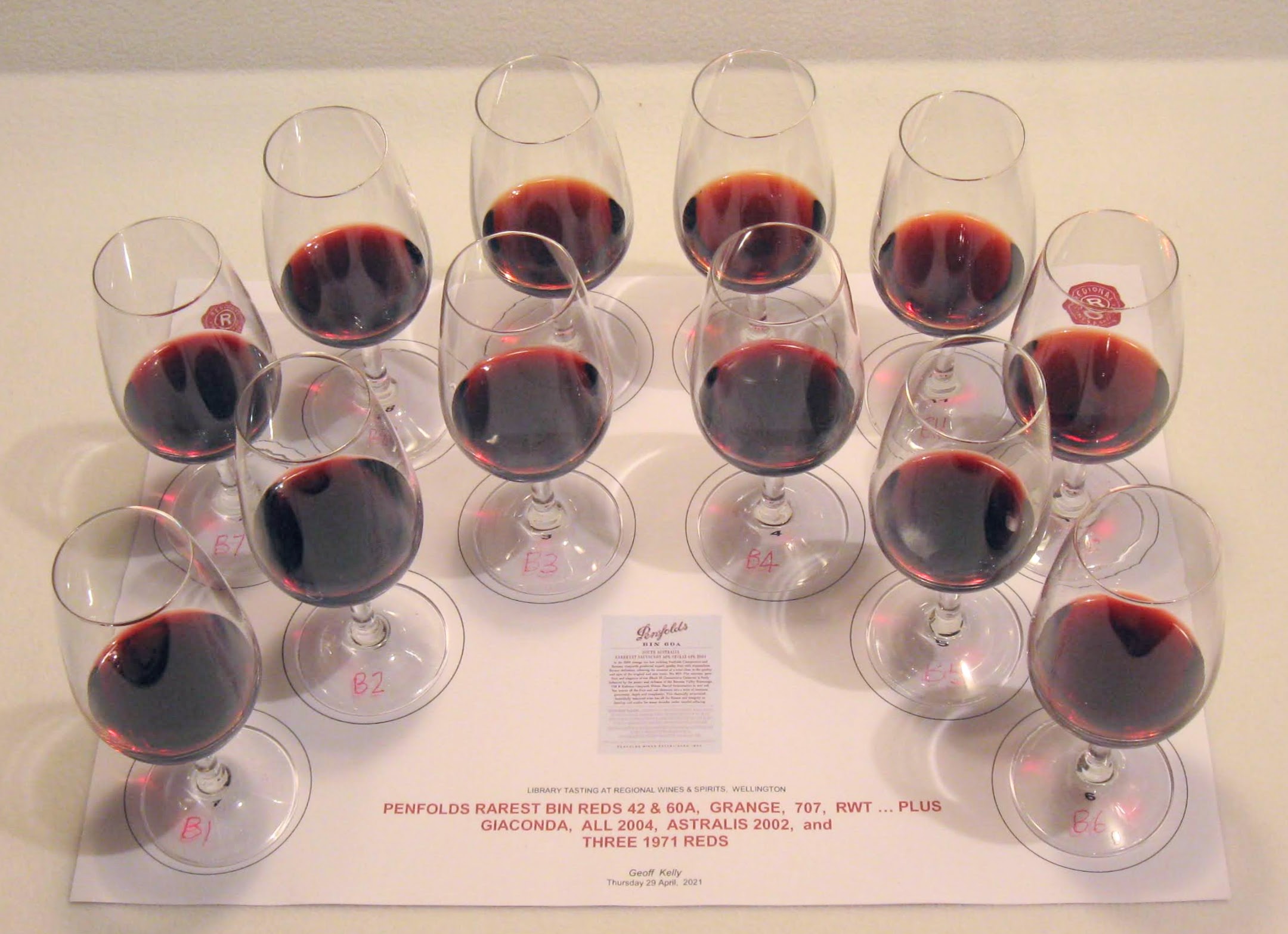
The twelve wines generated the most amazingly aromatic and berry-rich aroma around the glasses, really enticing and exhilarating. Dark cassis-like notes were the main sensation, plus fragrant near-cedary oak, and a generally piquant and exciting quality hard to describe. You could not wait to smell and taste them. Eight of the wines being so young, the colour gradation in the 2004s does not show up here, but wine 4, Penfolds Shiraz Grange, was the deepest and most intense colour, followed by wine 5, Penfolds Cabernet Sauvignon Bin 42. Wine 6, 2002 Clarendon Hills Syrah Astralis, despite its reputation, was the lightest in the front row. In the back row, wine 7 the 2004 Penfolds Bin 60A, was midway in depth, in the 12. Wines 9 to 12 are the 1970s wines, wine 11 the 1971 Tahbilk Cabernet being the darkest of these four, and wine 10 the 1971 Tahbilk Shiraz being the lightest, but still a very acceptable colour … at 50 years of age.
Ruby, carmine and velvet, youthful for its age, in the middle for depth of colour. Bouquet is aromatic, piquant, enticing, with wonderful dark fresh berry characters approaching cassis in quality, though it is hard to tease out the berry from aromatic new oak. The wine has a faint pennyroyal lift, almost subliminal, but making it exciting to smell. It is not euc'y. Palate follows perfectly, not overly rich or overstated, the cabernet speaking much more loudly at this stage, the wine having reminders of a young Bordeaux such as Mouton-Rothschild (with its noticeable oak), but then the palate is softened and fleshed-out by silky shiraz fruit, feeling as if it were free-run juice. Any acid adjustment for this wine is subtly done, it thus pretty well escaping the great peril of many Australian red wines, a spiky added-tartaric finish. When compared with Cabernet Sauvignon Bin 707 of the same year, the wine is gentler, more bordeaux-like, not as obviously American oak, and in particular it finishes more attractively. Great wine, and so far as you can tell not in any way closed or compacted by being bottled under screwcap. Top wine for four tasters, the top wine in that respect, and one second-favourite. Thought to be cabernet-dominant by half the group. Cellar 20 – 40 years. GK 04/21
Ruby and velvet, a good colour for its age, well above midway in depth. Bouquet is softer and ‘sweeter’ than the top Cabernets, less aromatic, less oaky, only the faintest piquant lift, instead nearly floral, with exquisite berry inclining mostly to blueberry, some red plum, no overt oak. Palate is beautiful, of syrah quality, great length, purity and depth, not obviously oaky, not obviously tartaric-adjusted, but instead long and 'sweet' on dry extract. I imagine against a very good Hermitage of the same age, the blueberry level of ripeness would seem a bit lush, but as a quality expression of syrah in a ripe year, this RWT would fare very well indeed. The alcohol is well hidden in the succulent berry, and any tartaric addition is well-nigh invisible. One top vote, one second, and mysteriously, two least. Seen as shiraz by half the group. Cellar 10 – 30 years. GK 04/21
Ruby, nearly carmine, and velvet, youthful for its age, the third deepest wine. Bouquet is intensely berried, with a light pennyroyal lift but not euc'y, like the 60A piquant and enticing, but the new oak a good deal more noticeable. The purity of berry on bouquet is captivating. Palate likewise is intensely cassisy, a staggering depth of berry and fruit, and much better balance of berry to oak than some of the heavily-handled later 1990s Bin 707s, the depth of fruit such that the length of flavour almost covers over any ‘cabernet hole’ in the palate. Only when you compare the palate carefully with the 60A, do you notice a relative shortness here, compared with the near-succulence of the 60A, with its benison of shiraz filling out the texture. Finish too is not as fine as the 60A, just a little tartaric spikiness is noticeable. It is a pity Penfolds do not pay relatively more attention to mouthfeel and texture, considering world wine standards, and less to pH meters. I would love to see this wine at 45 years, when some of the tartaric may be sparkling crystals on the cork, and the liquid thus gentler. Top wine for three tasters, and second-favourite for another three, so one of the top wines for the group. Recognised as cabernet-dominant by eight tasters. Cellar 25 – 40 years. GK 04/21
Ruby, a hint of garnet creeping in, velvet, midway in depth. Bouquet is intriguing, a soft and pure depth of plummy dark berry with cedary complexity factors woven through it. There is not quite the clinical purity of the young Penfolds wines, but instead an almost European complexity, softness, and charm. On palate the fruit is slightly ‘cooler’ than the RWT, hints of cassis and darkest black doris plummy berry, attractive oak of potentially cedary quality, and long, long richness. There is no hint of acid addition to the tail. If comparison with Hermitage was permissible for RWT, it is even more appropriate here, with its extra dimension of flavour complexity. Only fair to mention that this is the first ‘pure’ and sweet bottle of 2002 Astralis I have tasted, previous bottles having some brett complexity. In that regard, two tasters offered the descriptor ‘bacony’ for this wine. Recognised as shiraz-dominant by eight tasters. Top wine for two tasters. A lovely bottle, to cellar 10 – 30 years, noting that each bottle will be different. GK 04/21
Ruby and velvet, just above midway in depth. A voluminous bouquet augmented by a little spirit, and a pennyroyal lift, the cabernet component dominant at this stage of the wine’s evolution, quite a cassisy quality. On palate oak becomes noticeable, but the berry quality is so good, it just makes the wine intensely aromatic. As with Bin 60A, shiraz fills out and sweetens the palate, the wine building into a very aromatic mouthful. Only on the finish does the Penfolds preoccupation with pH show up, the tartaric addition being noticeable. All the same, this is an exceptionally flavoursome and harmonious 389, reminding of some offerings in the 1970s. A pity Penfolds were still skimping on corks in 2004, 46 mm, for what is a 50 year wine. Top wine for one taster, and second favourite for another. Cellar 15 – 35 years. GK 04/21
Ruby, carmine and velvet, clearly the youngest and deepest wine, a remarkably fresh colour for its age. Bouquet is deep, dark, pure, and intensely aromatic on both berry quality hinting at cassis, and noticeable oak. A spirity lift adds to the aromatic quality, with just a suggestion of pennyroyal, but nothing as coarse as euc. Nonetheless, the total bouquet is pretty assertive. In mouth the wine is saturated with flavour, incredibly deep and dry, but the exact nature of the fruit and berry quality is somewhat obscured by excessive oak. And the finish is spiky on tartaric acid, to a fault. In a year like 2004, when the possibility of real syrah quality might be captured, it is so sad that instead the fruit has been built into simply a too big and ‘monument’ winestyle. For all its concentration, purity and strength, in terms of oak handling, alcohol, and pH, the wine is simply too aggressive / bold. When it comes to wine with food, who wants a battleground ? And Penfolds do not help themselves, for having built an obviously 50-year plus wine, it is still in 2004 being bottled with a 49mm cork. Only 54 / 55 mm corks can be ‘guaranteed’ to last 50 years, as anybody seriously interested in mature wine knows. Who in truth wants a re-corked, topped up, adulterated wine, when with a decent cork at the outset, you can have the original ? Two people rated this wine top at the blind stage, but six had it as their second-favourite. In one sense therefore, for the group this was the most popular wine of the evening. And it will cellar exceptionally well: the 'consumerist' American estimate of cellar life above is ludicrous. Half the tasters recognised it as shiraz-dominant. Cellar 25 – 45 years. GK 04/21
Ruby and velvet, a good colour for its age, and the second-deepest. First impression on bouquet is a negative character, almost tainted, which one winemaker in the group characterised as ‘bushfire / smokey’. Behind that factor is a lot of berry hard to characterise, but dark, and a lot of hessian oak. Palate is an order of magnitude better than the bouquet – but to genuine wine lovers, bouquet is all-important. Berry is now clearly cassis, and the oak though noticeable is potentially cedary and fine-grained. Palate structure is softer and finer than Bin 707, with tartaric adjustment less noticeable. Total palate is narrower than Bin 60A, when compared with its shiraz flesh, but lovely in its detail. Were it not for the bouquet taint, this Block 42 would be the better wine, relative to Bin 707. Will that character on bouquet marry away, is therefore the question ? Less likely perhaps, under screwcap. One person rated this their top wine, and two their second-favourite, with one person rating it least. Cellar 25 – 40 years. GK 04/21
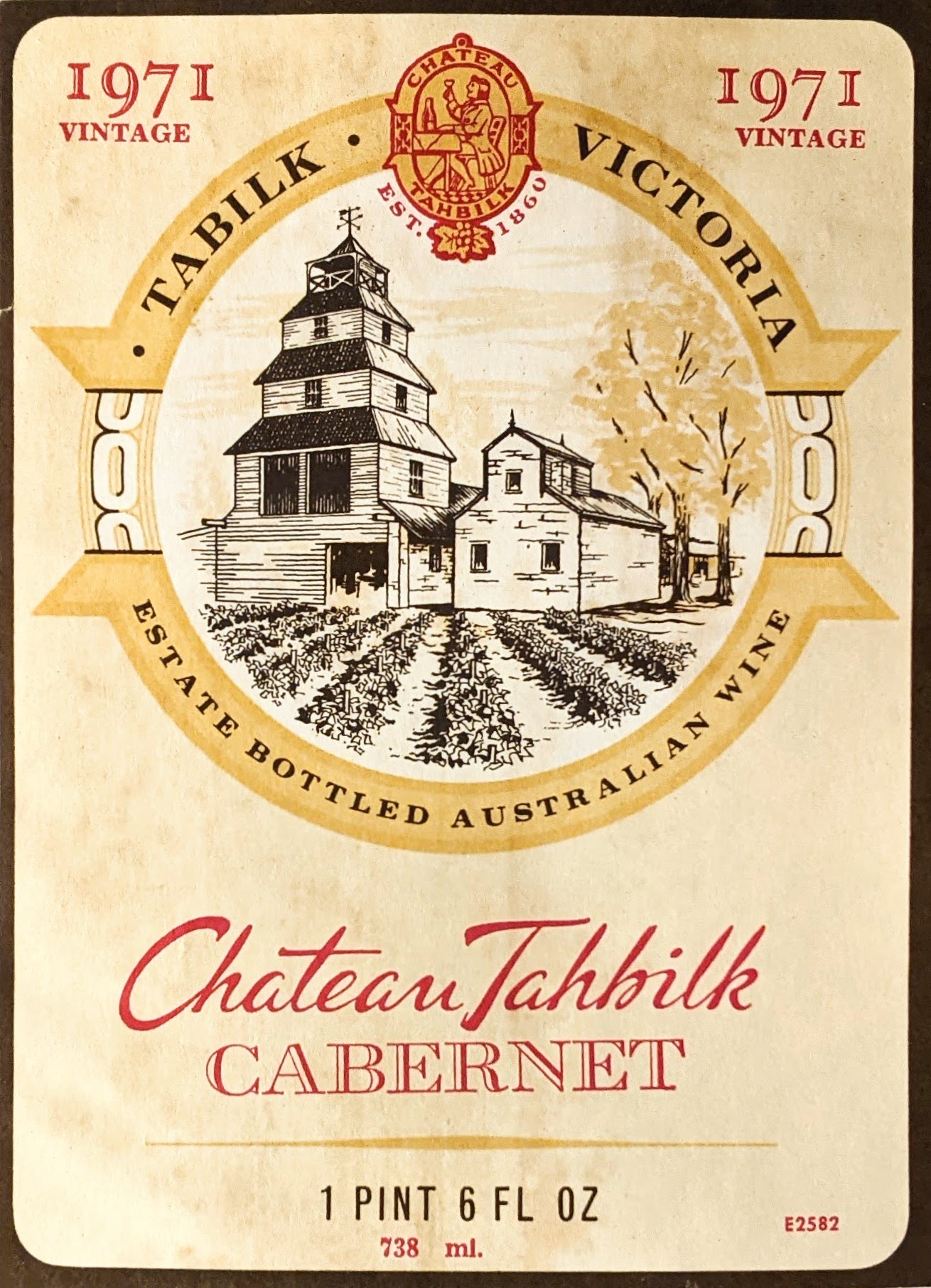
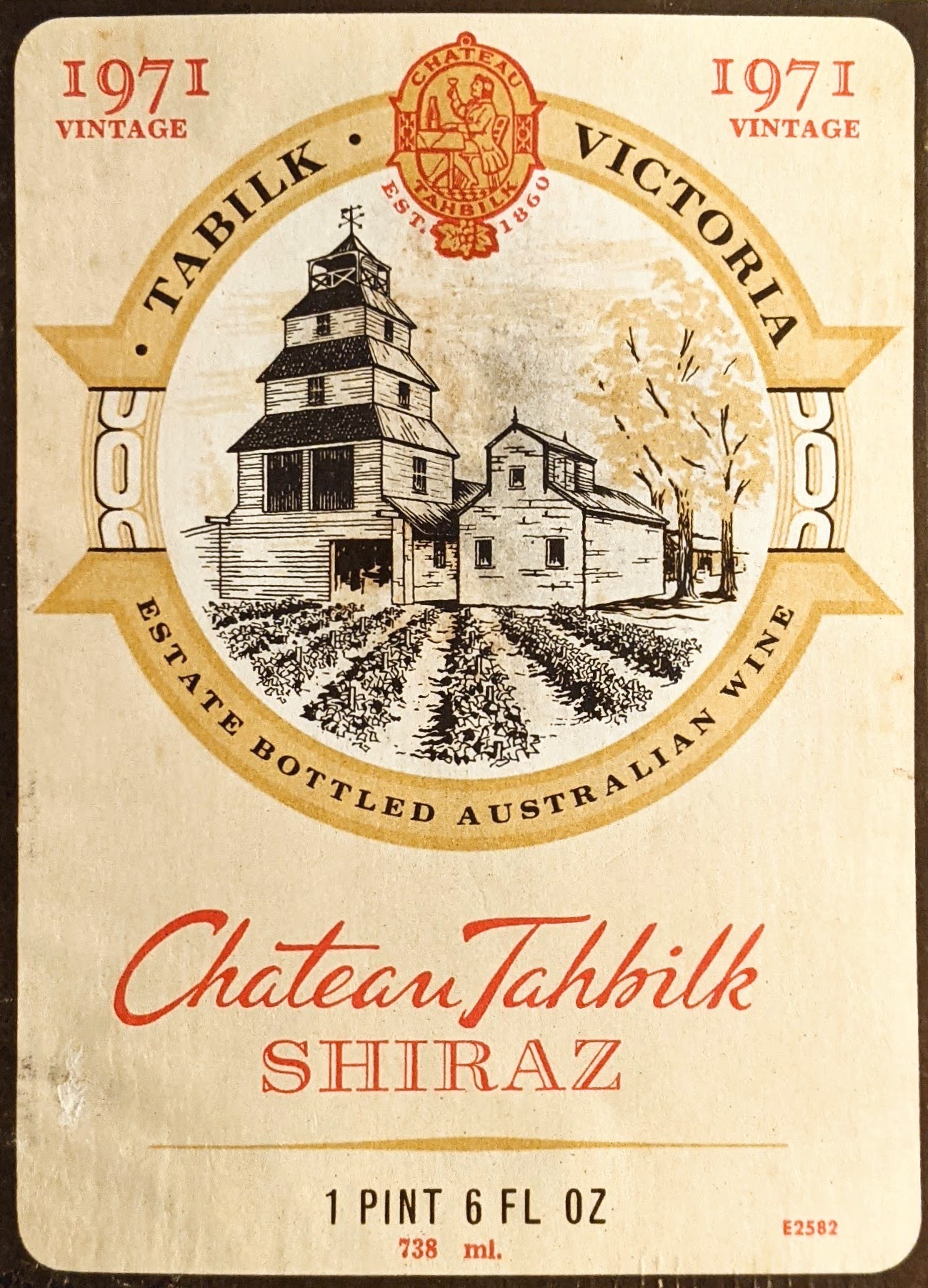
Garnet and browning ruby, below midway in depth. As is often the case with mature good wines, the Tahbilk Cabernet opened up over many hours. It was better the next day, in fact. What is remarkable is the purity of the berry and fruit, considering its age, the wine still almost showing fading / browning cassis aromatics, the latter augmented by a near-floral note reminiscent of the Australian flowering mint shrub Prostanthera. Palate has astonishing fruit for its age, and equally remarkable purity, considering there was little or no new oak for this wine, at that time. As Evans says, in their younger day, the 1971 Tahbilks seemed a bit solid against the lighter more fragrant 1969s and 1970s, but whereas the latter are fading now, this 1971 wine still has much to say. And the texture is mellow, no hint of acid addition. A very food-friendly wine, totally European in styling, as might be expected of Eric Purbrick. Second-favourite wine for three tasters. The wine is fully mature … and a bit too too old for some. Cellar future totally cork-dependent: as was the norm then, 46mm corks are standard, and 46mm cannot be guaranteed for 50 years. The corks are failing now. This bottle the best ullage of six checked for this tasting. GK 04/21
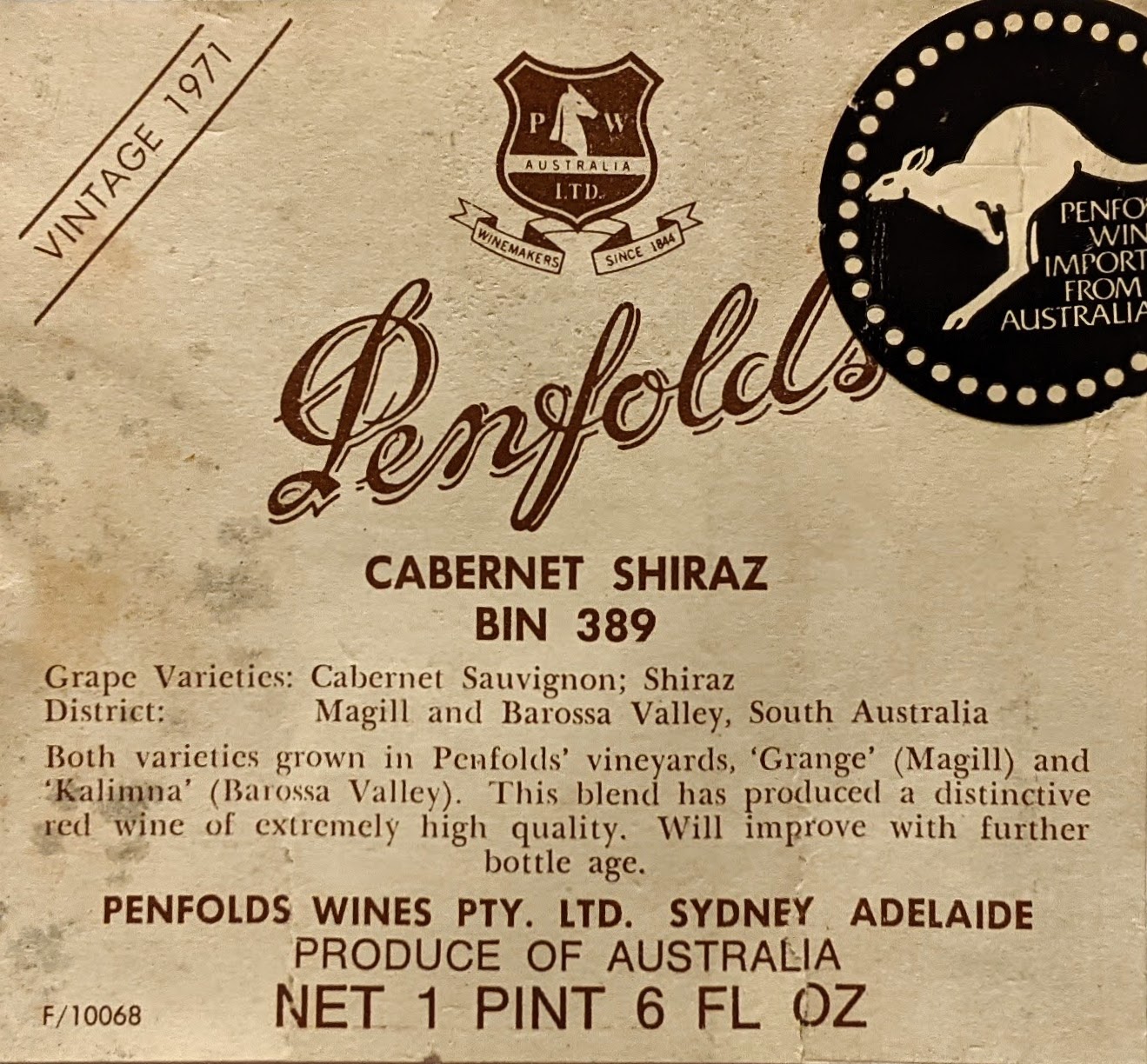
Medium ruby and garnet, the third to lightest. This wine did not quite gel for me, either at the tasting, or afterwards. There are better bottles … having started with a case (of 12). This bottle showed a complex interaction of fresher and newer oak than the two Tahbilks, yet on bouquet older and drier berry and fruit characters, with a faint suggestion of leathery / brett complexity, and trace VA. Palate marries these attributes up well, still surprisingly good fruit, all a bit leathery, but much better mouthfeel than the Giaconda. Tasters seemed to take the view that at 50 years of age, red wine is allowed to be less than perfect. Thus three people rated it the top wine of the evening, and three their second-favourite. Two had it as their least wine. There was certainly more ‘complexity’ than the two Tahbilks, which were a little one-dimensional in comparison, though purer. Again 46 mm corks, and they are failing, so best not cellar it much longer. GK 04/21
Rosy garnet and ruby, the lightest wine. At the tasting the wine was impaired by a light musty / TCA note, detected by seven tasters. Overnight it breathed off remarkably well, to reveal classic warmer-year Australian red-fruited shiraz, browning raspberry rather than boysenberry, like the Cabernet beautifully clean older oak, unlike the Cabernet no Prostanthera floral note. Palate is lighter and less tannic than the Cabernet, and in one sense therefore even better with food. Being less rich than the Cabernet, it was therefore too old for some. Top wine for one taster, but least wine for six, due to the light TCA. Time to drink up this wine, since like the Cabernet, the corks are failing. This bottle too the best ullage of six. Score reflects the well-breathed wine. GK 04/21
Ruby and garnet, markedly the oldest of the 2004s, below midway in depth. Bouquet is fragrant, complex, much older than the other 2004s, smelling both mature, and cooler-climate against the South Australian wines. There are suggestions of dark berries such as browning cassis or black doris plum, a hint of herbes, and savoury leathery notes bespeaking light brett, plus trace VA. Palate marries these diverse elements up quite well, a lighter wine but with reasonable body and dry extract, but then a sour note to the tail, though whether added acid, or more likely natural acid at the cooler (550m asl) Beechworth site in a cooler year, is unclear. Taken as a whole, as a mature wine it would be food-friendly, but it is not a wine for technical tasters. No first or second places, three least. Cellar a few years more, 10 maybe, but each bottle will be different. GK 04/21
Garnet and ruby, close to the Tahbilk Shiraz but not quite so rosy, the second lightest wine, and the oldest in appearance. Freshly opened, the wine showed ghostly browning berry and clean oak, all smelling harmonious but frail. For my first note at the decanting stage, I wrote: ‘clean, but this will be gone by tonight’. In the event the wine surprised me, hanging in there surprisingly well, clean, browning all through bouquet and palate, but still a suggestion of fruit, a hint of cloves, older oak, a bit acid (it was a cool year), but not empty. You would still happily drink it with a meal, if nothing better were offering. And in the event, one person liked it so much it was their top wine of the evening, while three had it least. A wine now fading away. GK 04/21
Reserve wines:
# 1999 Torbreck Shiraz The Factor, Barossa Valley, South Australia
14%; $162 Cork; J. Halliday, 2011: a powerful, dense bouquet with ripe plum to the fore, then gentle spice and positive oak. The smooth palate has plush, ripe, dark berry and plum fruit, fine tannins, and excellent oak integration, 95; https://torbreck.com
# 1994 Penfolds Shiraz Magill Estate, South Australia
13%; $143 Cork; H. Steiman@WS, 1998: Rich and generous in flavor, this is a complete wine, with spicy blackberry and chocolate flavors swirling through a finish that eases off a bit, making it feel elegant. Drink now through 2004. 3,200 cases imported, 90; www.penfolds.com
# 1981 Ch Tahbilk Shiraz 1860 [ pre-phylloxera vines ], Nagambie Lakes, Central Victoria
14%; $ – Cork; among the oldest pre-phylloxera (ungrafted) shiraz vines in the world; RH@JR, 2010: Raspberry and redcurrant, chocolate, fresh and lengthy with lovely depth and a leathery finish, 17; James Scarcebrook, 2015: … lifted aromatics, more toasty charred notes, smoked meats. Quite fresh for its age, sweeter oak tannin hanging in there, a bit of creamy texture, pretty lovely, more sweet breads. No score; www.tahbilk.com.au
© Geoff Kelly. By using this site you agree to the Terms of Use. Please advise me of errors.